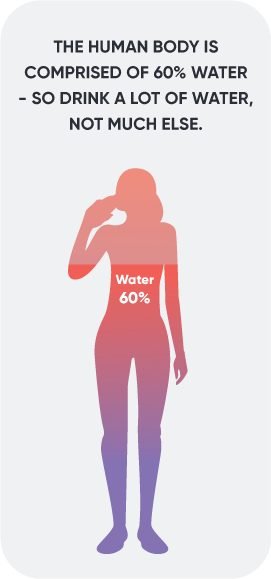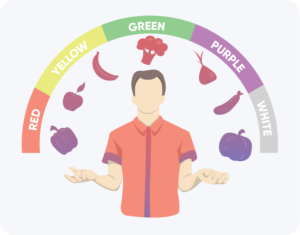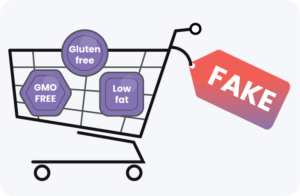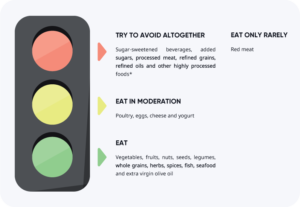5 min to read

1. EAT WHOLE FOODS
You attain the highest nutritional properties from food when you eat them in their most raw and whole form. This means eating more foods that are uncooked, unprocessed, and taking in nutrients that come from real, whole foods rather than nutritional supplements. Foods in their most natural form preserve their nutrients better. This includes things like: fiber, vitamins, minerals, and phytochemicals (compounds with antioxidant and anti-inflammatory effects).
In their whole form, foods are most protective from disease and promoting of health and longevity, but when they are cooked, ground up, or altered through different forms of processing, they lose many of their beneficial properties and nutrients. Processing may also degrade sensitive nutrients in the plant, such as vitamin C and many of the B vitamins. Additionally, when most foods are processed, ingredients such as refined sugars, salts, fats, and chemicals are added to “enhance flavor” or increase preservation.
2. EAT A PRIMARILY VEGETARIAN DIET
- It will protect you from disease. Eating a diet that incorporates vegetables as its primary source of nutrition may protect you from disease, lengthen your life, and help you maintain a healthy weight, according to a number of recent studies. A large trial called EPIC (European Prospective Investigation into Cancer and Nutrition), which included more than 74,000 adults, found that closer adherence to a plant-based diet was linked with lower risk of death from all causes.
- It will get you the most and best kind of nutrients. Plants are rich in fiber, vitamins, minerals, healthy fats, and phytochemicals.
- Plant-based foods tend to replace less healthful foods in your diet. The foods that plant-based foods can help sub out include things like fatty meats and high-fat dairy. Without having to “restrict food,” you will be able to eat a more healthy diet without feeling as deprived.
- To help with an initial diet switch and to turn your diet into a more plant-based one here are some suggestions:
– Turn your favorite meals into plant-based dishes. Find easy recipes for at least a few meatless meals and try to have one or two each week.- Instead of animal protein, eat at least 3 cups a week of legumes.- Include more whole soy and nut-based foods.- Combine simmered whole grains, sautéed or raw vegetables, and cooked legumes on your plate. This combination provides the perfect combination of proteins and carbohydrates to keep you feeling full and satisfied
3. LIMIT DAIRY INTAKE
The World Health Organization found a significant link between high consumption of full fat milk and prostate cancer deaths. Another study looked at women, namely the Swedish Mammography Cohort study, and found an association between high intake of dairy products and increased risk of ovarian cancer. Scientists believe that the link to disease may be related to a compound called insulin-like growth factor, which is found in cow’s milk. Today, there is increasing evidence that this overuse of antibiotics (used to make animals like cows gain weight to increase meat production for market) may contribute to antibiotic resistance in humans.
4. DRINK WATER, LOTS OF IT AND NOT MUCH ELSE

The human body is comprised of 60% water. Water is used for several vital functions including circulation, absorption, digestion and temperature regulation amongst several others. Additionally, research by Cian et al. published in the Journ
al of Psychophysiology in 2001 found that even mild dehydration can impair mood, memory, brain performance in individuals of any age. The body is also constantly losing fluids from such things as breathing, sweating, gastric emptying, etc. and it is important to replace these losses in order to maintain the levels of hydration necessary for these important bodily functions.
5. INCLUDE “HEALTHY FATS” INTO YOUR DIET
“Good fats” include fish oil, flax seeds, and sunflower seeds. These polysaturated fats are essential in your diet, meaning that your body cannot manufacture them, so you must get them from food. These fats are required for normal body function, including brain development, inflammation control, and blood clotting.
These fats are also important components of cell membranes, affecting the structure and properties of the cell. Some of these fats are found in very high concentrations in cells in the retina and brain. They also reduce total and LDL (bad) cholesterol and triglycerides.

6. SELECT “GOOD CARBS”
- Disease reduction. Research links whole grains, legumes, vegetables, and fruits—the “good” carbs—with a reduced risk of heart disease, certain types of cancer, type 2 diabetes, obesity, and cognitive impairment. Interestingly, research even suggests that the phytochemicals in plants, which act as antioxidants, may help promote more stable blood glucose levels—adding to the effects of fiber found in whole plants.
- Benefits of whole grains. Hundreds of studies link a diet pattern rich in whole grains with several health benefits, including a reduced risk of cardiovascular disease, type 2 diabetes, and colorectal cancer. A recent analysis including more than 350,000 participants in the NIH-AARP Diet and Health Study found that whole-grain consumption was linked with reduced rates of death, both from specific causes and in total. The fiberrich outer covering called bran slows down the breakdown of starch into glucose and helps the body maintain a steady blood sugar.
-
Benefits of fiber. Fiber slows down digestion and lowers the rate at which sugar from food enters your bloodstream. It also helps you feel fuller for a longer period of time and can help to reduce LDL cholesterol. It increases digestive health and has also been found to be associated with lower rates of diabetes, heart disease, and obesity.
7. EAT COMMUNALLY
A 2014 study published in the journal Nutrition Research and Practice and a 2015 study published in the journal Appetite, found that people who eat alone demonstrate poorer eating habits than those who eat with others. Unhealthy eating habits are more likely to occur in isolation. For example, stress eating and binge eating may be brought on more easily as people tend to engage in behaviors they would normally refrain from if they were in the presence of friends and family. Additionally, communal eating activates beneficial neurochemicals and also improves digestion.
The dining table provides an opportunity for conversation, storytelling, and reconnection. When you bond with others and experience a sense of connection, endogenous opioids and oxytocin are released that stimulate pleasant feelings. The neurochemical changes lead to improved well-being and contentedness.
8. EAT MINDFULLY
Mindless eating is at the core of many problems associated with unhealthy eating habits. Mindfulness has been shown to be effective in improving healthy nutrition. It helps individuals connect with internal hunger and satiety cues as well as allows for a reduction in external cues to eat at times when it is not nutritionally beneficial or necessary. It also enables individuals to take control of eating habits they may not be overtly aware of.
A controlled mixed method intervention study by Stanszus et al., 2019 employed an adapted mindfulness-based intervention (MBI) to investigate such potential effects in a healthy, adult student population. Results from both qualitative and quantitative data indicate that the MBI exerts strong effects on mindful eating, and that the effects on sustainable nutritional behaviors appear in the qualitative data as content concerning pre-behavioral stages of consumption, such as attitudes and intentions. MBIs are an effective way to change unhealthy, mindless eating habits.
9. EAT TAKING INTO ACCOUNT SPECIFIC MEDICAL NEEDS
It is important to note that no dietary guideline or regimen should override any recommendation made by a doctor, dietician, other medical provider for a particular individual or condition. People with certain medical conditions may require special dietary considerations or modifications to meet their needs. For example, individuals with diabetes should eat consistent amounts of food daily at similar times each day in order to regulate their blood sugars. Other individuals who might be struggling with high cholesterol should limit the amount of saturated fat they include in their diet. The type of diet that is optimal for one person may not be optimal for another depending on individualized health needs.
10. LIMIT YOUR INTAKE OF SALT AND SUGAR
Salt is linked to high blood pressure (hypertension) which is the leading cause of cardiovascular disease and affects approximately one out of every three Americans. According to the World Health Organization, salt intake of less than 5 grams per day for adults not only helps to reduce blood pressure and risk of cardiovascular disease but also decreases the likelihood of stroke and coronary heart attack.
Excessive sugar consumption is also problematic and is linked to several adverse health conditions including obesity and metabolic syndrome, heart disease, type 2 diabetes, high blood pressure and cholesterol, inflammation, fatty liver disease, dental problems. The National Institute of Health (NIH) estimate that American adults get 15 percent of calories in their diet from added sugars alone not accounting for the natural sugars found in products such as fruit and milk.
Many individuals are unaware that added salts and sugars are abundant in food that does not come in its natural form. The majority of added salt and sugar in people’s diets comes from processed foods, and cutting down the consumption of packaged goods can have a significant impact in lowering a person’s salt and sugar intake.
11. PAIR YOUR PROTEINS WITH YOUR CARBS
Consuming protein and carbs together increases satiety and controls blood sugar. The Journal of Nutrition published a study in 2006 that stated that adding protein to a meal reduced the glycemic index of carbohydrates in that meal. Additionally, combining carbs and proteins after a workout has benefits for athletic performance. According to Christopher Mohr of the Academy of Nutrition and Dietetics, the carbs help to replenish glycogen in the muscles while protein repairs damaged muscle tissue.
12. PRIORITIZE FOOD THAT IS LOCALLY SOURCED AND IN SEASON
Locally grown food is taken from its original source at the peak of ripeness and typically arrives at a local store or stand within 24 hours. This is very different than food that is being harvested early to account for travel time to a market far away from where it is originally sourced. Additionally, eating locally sourced food is a way that you can also eat seasonally, meaning that you are only eating food that is being grown and sold in season, because you are not trying to access food that is not apt to grow in your environment at a particular time of year and having to sacrifice freshness and nutrient quality in order to purchase food that has been brought in from other areas where it might be in season. These foods, imported from other states or even countries tends to be older and has stopped at several distribution centers prior to its final destination.
13. EAT THE RAINBOW
This is an easy way to remember that the color of your food can tell you a lot about the nutritional value of what you are eating. Eating many different colors of food is a way to ensure that you are getting the largest variety of vitamins and minerals as possible.

RULES FOR PROCESSED FOOD
1. PAY ATTENTION TO THE INGREDIENTS. ONLY EAT THINGS THAT ARE ACTUALLY “FOOD”
-
Think about the way our ancestors ate. This means, stay away from things that our ancestors wouldn’t have recognized or wouldn’t have eaten.
-
Don’t eat anything with more than 5 ingredients or ingredients you cannot pronounce. If you don’t recognize one of the ingredients as a real food, then it’s probably not. The words on the list that you don’t understand are there as preservatives so that the food can sit on the shelf for a long time without going bad. Even though you may not know the scientific name of some vitamins, in reality even these are there to help with shelf life.
2. REMEMBER THAT LABELS ARE DECEIVING
Labels that say things like: natural, GMO free, organic, low fat, heart healthy, gluten free tell you nothing about whether a food is healthy for you. If a food has to convince you it’s good for you, it probably isn’t.

3. DON’T EAT ANYTHING THAT WON’T EVENTUALLY ROT
Fruit, vegetables, meat rot because they are real food! Heavily processed things like Oreos, Twinkies, other processed snacks do not. Even naturally processed foods like sauerkraut will eventually rot.
4. TRY NOT TO GET FOOD THAT IS ON THE INNER AISLES OF THE STORES, RATHER, STAY ON THE PERIMETERS WHERE THE FRESH FOOD IS
Next time you go to the grocery store notice how it is laid out. The refrigerators and produce are on the outside while the boxed foods are on the inner aisles. There may be some good things in there, but do 90% of your shopping on the perimeters.
5. AVOID ANYTHING ADVERTISED ON TV
These are the foods that were designed with the intention of making a profit. These companies put profits way above quality. They are what you see at convenient stores, gas stations, the inner aisles of the grocery store, or most prominent, fast food.

6. LIMIT THE FREQUENCY WITH WHICH YOU EAT AT FAST FOOD RESTAURANTS
Restaurants add additives that you might not be aware of. For example, there is dythylpolysiloxane aka silly putty in your McDonalds French fries and formaldehyde in your Chick-fil-a sandwiches. There is little ingredient regulation in these establishments.
THE STOPLIGHT METHOD

* Examples of foods/ingredients to avoid
- Added sugar: Soda, candies, ice cream, table sugar and many others.
- Refined grains: White bread, pasta made with refined wheat, etc.
- Trans fats: Found in margarine and various processed foods.
- Refined oils: Soybean oil, canola oil, cottonseed oil and others.
Arete Training Partner application form
Wow, you’re awesome!
We are happy to see you are interested in Arete. Just give us some time to think and get back to once we are ready. Thank you!
Oops! Something went wrong.

Member support:
support@aretepeakperformance.comWant to become a Training Partner? Please visit Join our team.


